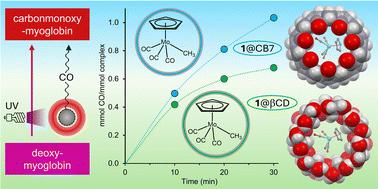当前位置:
X-MOL 学术
›
Dalton Trans.
›
论文详情
Our official English website, www.x-mol.net, welcomes your
feedback! (Note: you will need to create a separate account there.)
β-Cyclodextrin and cucurbit[7]uril as protective encapsulation agents of the CO-releasing molecule [CpMo(CO)3Me]
Dalton Transactions ( IF 3.5 ) Pub Date : 2024-11-11 , DOI: 10.1039/d4dt01863j Rodrigo P. Monteiro, Isabel B. Calhau, Ana C. Gomes, André D. Lopes, José P. Da Silva, Isabel S. Gonçalves, Martyn Pillinger
Dalton Transactions ( IF 3.5 ) Pub Date : 2024-11-11 , DOI: 10.1039/d4dt01863j Rodrigo P. Monteiro, Isabel B. Calhau, Ana C. Gomes, André D. Lopes, José P. Da Silva, Isabel S. Gonçalves, Martyn Pillinger

|
The CO releasing ability of the complex [CpMo(CO)3Me] (1) (Cp = η5-C5H5) has been assessed using a deoxymyoglobin-carbonmonoxymyoglobin assay. In the dark, CO release was shown to be promoted by the reducing agent sodium dithionite in a concentration-dependent manner. At lower dithionite concentrations, where dithionite-induced CO release was minimised, irradiation at 365 nm with a low-power UV lamp resulted in a strongly enhanced release of CO (half-life (t1/2) = 6.3 min), thus establishing complex 1 as a photochemically activated CO-releasing molecule. To modify the CO release behaviour of the tricarbonyl complex, the possibility of obtaining inclusion complexes between 1 and β-cyclodextrin (βCD) or cucurbit[7]uril (CB7) by liquid–liquid interfacial precipitation (1@βCD(IP)), liquid antisolvent precipitation (1@CB7), and mechanochemical ball-milling (1@βCD(BM)) was evaluated. All these methods led to the isolation of a true inclusion compound (albeit mixed with nonincluded 1 for 1@βCD(BM)), as evidenced by powder X-ray diffraction (PXRD), thermogravimetric analysis (TGA), FT-IR and FT-Raman spectroscopies, and 13C{1H} magic angle spinning (MAS) NMR. PXRD showed that 1@βCD(IP) was microcrystalline with a channel-type crystal packing structure. High resolution mass spectrometry studies revealed the formation of aqueous phase 1 : 1 complexes between 1 and CB7. For 1@βCD(IP) and 1@CB7, the protective effects of the hosts led to a decrease in the CO release rates with respect to nonincluded 1. βCD had the strongest effect, with a ca. 10-fold increase in t1/4 for dithionite-induced CO release, and a ca. 2-fold increase in t1/2 for photoinduced CO release.
中文翻译:

β-环糊精和葫芦[7]脲作为一氧化碳释放分子[CpMo(CO)3Me]的保护性包封剂
已使用脱氧肌红蛋白-碳一氧肌红蛋白测定评估了复合物 [CpMo(CO)3Me] (1) (Cp = η5-C 5H5) 的 CO 释放能力。在黑暗中,还原剂连二亚硫酸钠以浓度依赖性方式促进 CO 释放。在较低的连二亚硫酸盐浓度下,连二亚硫酸盐诱导的 CO 释放最小,用低功率紫外灯在 365 nm 处照射导致 CO 的释放强烈增强(半衰期 (t1/2) = 6.3 min),从而将复合物 1 建立为光化学激活的 CO 释放分子。为了改变三羰基络合物的 CO 释放行为,评估了通过液-液界面沉淀 (1@βCD(IP))、液体反溶剂沉淀 (1@CB7) 和机械化学球磨 (1@βCD(BM)) 获得 1 和 β-环糊精 (βCD) 或葫芦[7]uril (CB7) 之间的包合物的可能性。粉末 X 射线衍射 (PXRD)、热重分析 (TGA)、FT-IR 和 FT-拉曼光谱以及 13C{1H} 魔角旋转 (MAS) NMR 证明了这一点,所有这些方法都导致了真正的包涵物的分离(尽管与非内含物 1 对 1@βCD (BM)] 混合。PXRD 显示 1@βCD(IP) 是微晶,具有通道型晶体填充结构。高分辨率质谱研究揭示了在 1 和 CB7 之间形成 1 : 1 水相复合物。 对于 1@βCD(IP) 和 1@CB7,宿主的保护作用导致相对于非包涵体 1 的 CO 释放速率降低。βCD 的效果最强,连二亚硫酸盐诱导的 CO 释放的 t1/4 增加了约 10 倍,光诱导 CO 释放的 t1/2 增加了约 2 倍。
更新日期:2024-11-12
中文翻译:

β-环糊精和葫芦[7]脲作为一氧化碳释放分子[CpMo(CO)3Me]的保护性包封剂
已使用脱氧肌红蛋白-碳一氧肌红蛋白测定评估了复合物 [CpMo(CO)3Me] (1) (Cp = η5-C 5H5) 的 CO 释放能力。在黑暗中,还原剂连二亚硫酸钠以浓度依赖性方式促进 CO 释放。在较低的连二亚硫酸盐浓度下,连二亚硫酸盐诱导的 CO 释放最小,用低功率紫外灯在 365 nm 处照射导致 CO 的释放强烈增强(半衰期 (t1/2) = 6.3 min),从而将复合物 1 建立为光化学激活的 CO 释放分子。为了改变三羰基络合物的 CO 释放行为,评估了通过液-液界面沉淀 (1@βCD(IP))、液体反溶剂沉淀 (1@CB7) 和机械化学球磨 (1@βCD(BM)) 获得 1 和 β-环糊精 (βCD) 或葫芦[7]uril (CB7) 之间的包合物的可能性。粉末 X 射线衍射 (PXRD)、热重分析 (TGA)、FT-IR 和 FT-拉曼光谱以及 13C{1H} 魔角旋转 (MAS) NMR 证明了这一点,所有这些方法都导致了真正的包涵物的分离(尽管与非内含物 1 对 1@βCD (BM)] 混合。PXRD 显示 1@βCD(IP) 是微晶,具有通道型晶体填充结构。高分辨率质谱研究揭示了在 1 和 CB7 之间形成 1 : 1 水相复合物。 对于 1@βCD(IP) 和 1@CB7,宿主的保护作用导致相对于非包涵体 1 的 CO 释放速率降低。βCD 的效果最强,连二亚硫酸盐诱导的 CO 释放的 t1/4 增加了约 10 倍,光诱导 CO 释放的 t1/2 增加了约 2 倍。


















































 京公网安备 11010802027423号
京公网安备 11010802027423号